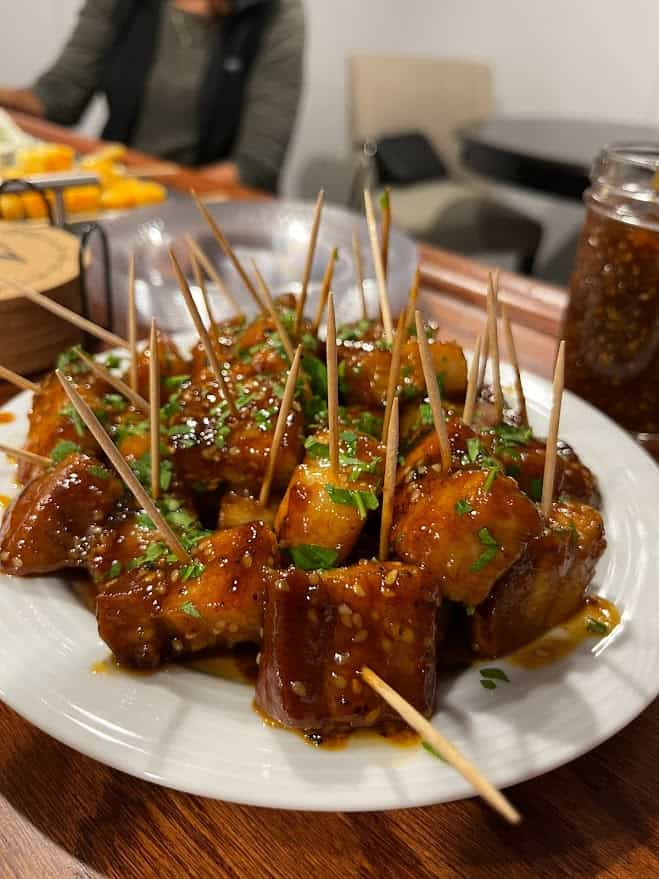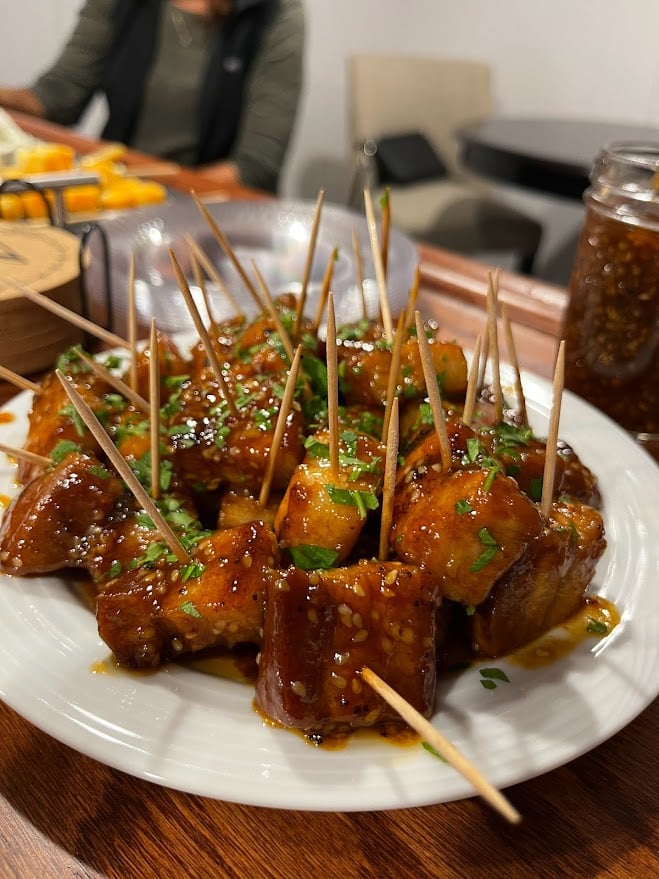
With sous vide becoming a more accessible kitchen tool, I feel it is often seen as the one method home cooks should use to cook anything, and the truth is, it isn’t. While you technically could cook anything that fits in a bag with a sous vide, it doesn’t mean you need to.
This post will share my opinions and when to use sous vide and when not to, and how to set yourself up for a quick and easy appetizer you can have ready in minutes.
First, what is sous vide? Directly translated to under the vacuum, sous vide is a method of preparing food with the added help of an immersion circulator (which often is given the title of sous vide, when in reality sous vide is the method.) Think like baking is done with an oven, sous vide is done with an immersion circulator.
The appliance does exactly as its name would suggest, it is immersed in water and circulates that water around the container. The cool thing about this gadget is it increases and maintains the temperature of the water at an extremely exact temperature, some machines keeping it consistent to .1 of a degree. When you add food placed in a vacuum-sealed bag, you can cook that food to very exact temperatures. The sealed bag allows whatever is inside to cook alongside its own juices as well as any seasoning or marinades added to the bag, with no loss like in other cooking methods. The temperature control also allows for the food to be cooked for extended periods of time without being considered overcooked. This helps to tenderize the food, breaking down the fibers like you would see in a braise, but with the temperature never going over what you set it to. However, food can go too long in a sous vide, making it a bit mushy.
Once this food has been cooked with the circulator, it is often hit with high heat to develop some amount of crust. We usually see this with meat, which can be done on a ripping hot skillet, grill or with a kitchen torch. The final searing needs to be done at high temps so as to not cook the inside any further, the sous vide took care of that. The result is a tender and perfectly temped (notice I didn’t say cooked, more on that later) piece of food. As far as cooking temps and times, the internet is going to be your best source. The manufacturers of immersion circulators will have published guides to different foods and expected outcomes, as well as different food-publications. Do a little research and go with your gut on which is going to be best for you.
Another concept to understand with sous vide is its ability to preserve foods. When you cook something in a completely sealed environment, you are essentially pasteurizing it. Which according to “Douglas Baldwin’s Sous Vide for the home cook” can be stored:
- below 36.5°F (2.5°C) for up to 90 days,
- below 38°F (3.3°C) for less than 31 days,
- below 41°F (5°C) for less than 10 days, or
- below 44.5°F (7°C) for less than 5 days.
This means you can utilize a sous vide for meal prepping, or to have ready-to-go food in your freezer for cravings or last minute get togethers. This is all, of course, assuming they are in properly vacuum sealed bags. The Ziploc trick is completely fine for beginners but food in these bags will not keep fresh as long as true vacuum-sealed bags.
So, what foods should use sous vide and what shouldn’t? A lot of chefs will have different opinions on sous vide and its effectiveness, but I will share from my own experiences and preferences. I urge you to experiment with different ingredients and find what’s best for you. In my opinion, I employ sous vide for its ability to tenderize food and for that pasteurization trick. That means tougher cuts of meat like skirt steaks or pork bellies. But I have heard rave reviews on chicken breasts and carrots. The truth is that it is entirely up to you and your preferences on what to sous vide and not. The times when I would specifically opt-out of sous vide are when I am in a hurry and don’t have the time to set up a slow cooking process, or when I know something will be great without the added work. A nice prime ribeye, a quick sear and finish with butter is about as good as I need it to be, regardless of what the sous vide can offer. But this pork belly is an absolute favorite of mine.

Sweet and Spicy Gochujang Pork Belly
Scroll down for a printable recipe
Yield: 8-16 servings
Prep Time: 10 minutes
Cook Time: 7-24 hours
Total Time: 7-24 hours
1 pound pork belly, skin off
Salt and pepper
4 Tablespoons gochujang
4 Tablespoons honey
4 Tablespoons soy sauce
4 Tablespoons water
2 Tablespoons sesame seeds
1 Tablespoon chili crisp/crushed red pepper
Chives, green onions or cilantro, for garnish
Sesame oil
- Slice pork belly into manageable pieces that can fit in vacuum or Ziploc bag.
- Season generously with salt and pepper.
- Place belly in vacuum bags and seal or in Ziploc bags and seal using displacement. (*see note, below)
- Cook the belly sous vide @160F for 7-24 hours. The time difference will determine the how tender the belly is:
- At around 7 hours, the belly will still have some chew but nicely tender.
- After 10 hours, the belly will be soft and melt-in-your-mouth.
- 24 hours of cooking will yield tender fall-apart pieces of belly.
- After it is complete, drop full bags into ice water until cool. Freeze for up to 90 days.
After Freezing/From Fridge
- Defrost belly in refrigerator.
- Cut belly into squares as an appetizer or left whole as a main course, keep all the drippings from the bag.
- Sear on high in a ripping hot cast iron pan, or broil on high in oven until well seared on all sides.
- While pork is searing, combine gochujang, honey, soy sauce, sesame and chili crisp in a pan and bring to a boil.
- Reduce until a thin syrupy texture and turn off heat.
- Toss belly and its juices in sauce and garnish.
- Drizzle with small amount of sesame oil.
*Displacement method: Place ingredients in a plastic bag and lower into water to remove air from around the ingredients inside the bag, then seal the bag.
We don't offer sous vide classes at The Chopping Block due to the length of cooking time, but if you are looking for a class to give you a solid foundation in the kitchen, don't miss our Essential Building Blocks on Friday, March 1 at 9am. You'll spend a day in our kitchen exploring the basic science and techniques all cooks should know.

Sweet and Spicy Gochujang Pork Belly
Ingredients
- 1 pound pork belly, skin off
- Salt and pepper
- 4 Tablespoons gochujang
- 4 Tablespoons honey
- 4 Tablespoons soy sauce
- 4 Tablespoons water
- 2 Tablespoons sesame seeds
- 1 Tablespoon chili crisp/crushed red pepper
- Chives, green onions or cilantro, for garnish
- Sesame oil
Instructions
- Slice pork belly into manageable pieces that can fit in vacuum or Ziploc bag.
- Season generously with salt and pepper.
- Place belly in vacuum bags and seal or in Ziploc bags and seal using displacement. (*see note, below)
- Cook the belly sous vide @160F for 7-24 hours. The time difference will determine the how tender the belly is: at around 7 hours, the belly will still have some chew but nicely tender. After 10 hours, the belly will be soft and melt-in-your-mouth. 24 hours of cooking will yield tender fall-apart pieces of belly.
- After it is complete, drop full bags into ice water until cool. Freeze for up to 90 days.
- Defrost belly in refrigerator.
- Cut belly into squares as an appetizer or left whole as a main course, keep all the drippings from the bag.
- Sear on high in a ripping hot cast iron pan, or broil on high in oven until well seared on all sides.
- While pork is searing, combine gochujang, honey, soy sauce, sesame and chili crisp in a pan and bring to a boil.
- Reduce until a thin syrupy texture and turn off heat.
- Toss belly and its juices in sauce and garnish.
- Drizzle with small amount of sesame oil.

